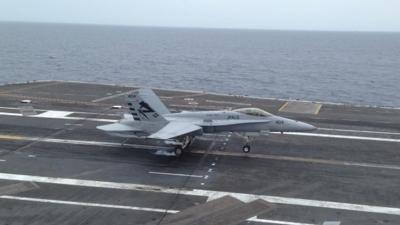Sat, Jun 29, 2013
Joint Precision Approach And Landing System Trials Conducted Aboard USS George H.W. Bush
Landing on an aircraft carrier is now safer thanks to the Joint Precision Approach and Landing System (JPALS) team from the Naval Air Traffic Management Systems Program Office (PMA-213). JPALS is an all-weather landing system that uses a Global Positioning System and navigation systems to safely land both land- and sea-based aircraft. JPALS completed its latest round of testing aboard the USS George H.W. Bush (CVN 77) in late May.

The 52-person team spent 11 days aboard the carrier testing the latest JPALS software with two F/A-18C Hornet aircraft from Air Test and Evaluation Squadron (VX) 23, and an MH-60S helicopter from Air Test and Evaluation Squadron (HX) 21, based at Naval Air Station Patuxent River. A modified Beechcraft King Air flying from St. Mary’s County Airport was also used as a test bed aircraft.
“The Hornets flew 65 low approaches to touch-and-go or full-stop landings during our two weeks on CVN 77,” said Lee Mason, PMA-213’s JPALS Ship System integrated program team lead. “The King Air completed 29 low approaches. So far, we are very pleased with the results. The system is expected to achieve tremendously improved landing accuracy.” With the completion of this two-week test period, the JPALS program transitioned into the second phase of integrated test, establishing the system requirements verification for JPALS, Mason added.
“The data generated from this two-week, at-sea period is undergoing detailed analysis by our experts. This analysis will, in turn, be used to validate and verify the system is accurate and working,” said Capt. Darrell Lack, PMA-213 program manager.
Later this summer, JPALS is scheduled to complete additional at-sea testing to further refine the verification and validation effort and enable the completion of the operational assessment of the JPALS ship system, which is needed to progress to the program’s next milestone, Lack added. “JPALS will provide adverse weather, adverse terrain, day and night, and survivable precision approach and landing capability that supports service and multi-national interoperability,” Lack said. “It is particularly suitable for the F-35, future aircraft and unmanned air vehicle operations at sea.”
(Image provided by the U.S. Navy.)
More News
Performance-Based Navigation (PBN) [ICAO] Area navigation based on performance requirements for aircraft operating along an ATS route, on an instrument approach procedure or in a d>[...]
The Airplane Came To Rest Underneath A Set Of Damaged Power Distribution Lines On The Floor Of A Coulee On June 19, 2025, at 1412 mountain daylight time, a Cessna 172K airplane, N7>[...]
Aero Linx: FAA Managers Association (FAAMA) Recognized by the FAA, FAAMA is a professional association dedicated to the promotion of excellence in public service. The Association i>[...]
From 2023 (YouTube Edition): Jet Central Micro-Turbine Engines Impress Founded in the late-1990s, Mexico City-based Jet Central produces a unique and fascinating line of micro-turb>[...]
Also: ANOTHER Illegal Drone, KidVenture Educational Activities, Record Launches, TSA v Shoes The Senate confirmed Bryan Bedford to become the next Administrator of the FAA, in a ne>[...]
 ANN's Daily Aero-Term (07.10.25): Performance-Based Navigation (PBN) [ICAO]
ANN's Daily Aero-Term (07.10.25): Performance-Based Navigation (PBN) [ICAO] NTSB Prelim: Cessna 172
NTSB Prelim: Cessna 172 ANN's Daily Aero-Linx (07.10.25)
ANN's Daily Aero-Linx (07.10.25) Classic Aero-TV: The Big Business of Diminutive Powerplants
Classic Aero-TV: The Big Business of Diminutive Powerplants Airborne 07.11.25: New FAA Bos, New NASA Boss (Kinda), WB57s Over TX
Airborne 07.11.25: New FAA Bos, New NASA Boss (Kinda), WB57s Over TX



